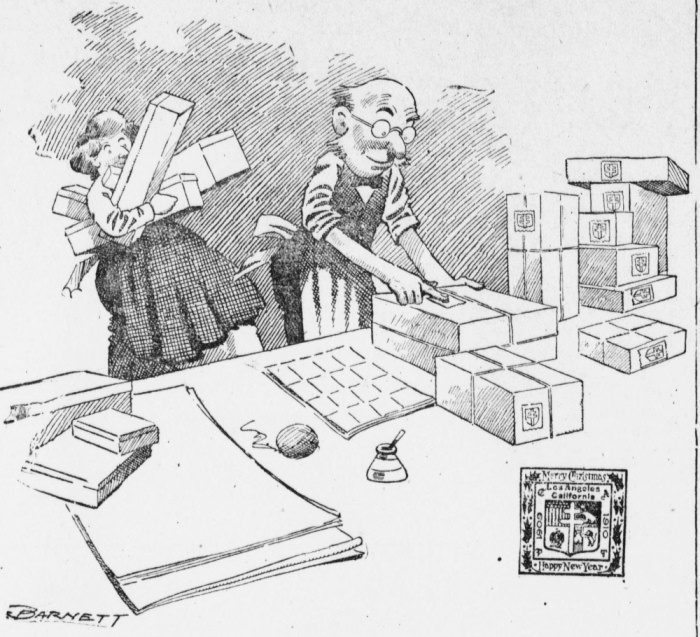The julemærke, or Christmas Seal as it is known in English, has become a tradition in many nations across the world. Few know, however, that the idea originated in Denmark, Copenhagen to be precise, and that the brainwave of one man has helped to raise millions of kroner over the last century.
Origins in Østerbro
Einar Holbøll was born in Østerbro on 20 December 1865 and raised in a house on Rævegade in the Nyboder district. The entire area was housing for naval officers and their families, and like his ancestors, the young Holbøll wanted to go to sea.
In 1880, he realised his dream when he joined the crew of the frigate Jylland as a volunteer apprentice. The ship sailed for the Danish West Indies (now the US Virgin Islands), and by all accounts Holbøll enjoyed life at sea. However, shortly afterwards he was forced to abandon his chosen career due to problems with his eyes.
The clerk with the spark
Back on dry land, Holbøll entered the post office as a postal clerk. It was as he sat in the post office on Købmagergade in 1903, surrounded by masses of Christmas post, that he came up with a revolutionary idea. Since people were sending so much post and Christmas was a time of generosity, then why not combine the two?
Holbøll’s idea was for a voluntary Christmas seal that people could put on their letters together with a normal stamp. All proceeds from the seal would go to help sick children.
Cheers Christian!
King Christian IX gave his permission for the idea to go ahead and on 13 December 1904, the first Christmas Seal was released, bearing a photograph of Queen Louise, and selling for two øre.
At that time, tuberculosis was a serious problem in many countries, and the proceeds from the first six years of the seals were donated to helping children with the disease. Thus, in 1911, the first ‘Christmas seal sanatorium’ was opened in Kolding in Jutland. The home was built specifically to deal with TB patients and included sick rooms, x-ray facilities, a schoolroom and recuperation areas.
Promoted to postmaster
By this time, Holbøll was a postmaster in Charlottenlund, just north of Copenhagen, and in 1912 he founded another scheme. Based on a similar idea relating to his eyesight problems, he launched a specially-minted coin to help the Danish Foundation for the Blind.
Despite Hølboll moving on to new projects, his Christmas Seal continued to raise huge amounts of money. In 1912, two more homes were refurbished for occupation by children, and in 1914, another purpose-built house was opened in Svendborg.
For the duration of the First World War, any funds raised went to maintaining the homes that were already established. However, in the years that followed, the organisation expanded rapidly and in various different directions. The home that opened in 1939 in Hobro was specifically for the care of asthmatic children, and in 1947, a home opened in northern Zealand only took in toddlers.
The seals’ purpose was, of course, to raise funds, but the images featured on the stamps were carefully thought out. Common motifs included children, winter landscapes, elves (nisser) and members of the royal family. In 1940, when Denmark was occupied by Nazi Germany, the seal showed a dove holding an olive branch to represent peace. Fittingly, in 1945, following liberation, the seal showed a billowing Dannebrog in a vibrant expression of national pride.
Advent of the series
Although the original seal was only one image, since 1951 a series published on the same theme has been produced each year, and these are sold in sheets of 50. The seal has also kept abreast of modern technology: recognising that electronic mail is taking off, an e-Christmas Seal, which people can buy and attach to their emails, was launched in 2002.
However, if the use of post offices is declining, the use of the Christmas Seal is not. Since 1971, four more Julemærkehjemmet (Christmas seal homes) have opened, offering 140 places to children who need them. There are, however, a reported 500 more on a waiting list for a place.
According to the foundation’s website, the problems that children face these days are more psychological and social, compared to the physical issues faced by their counterparts a century ago. The main issues that the foundation focuses on are low self-esteem and loneliness. Often this comes as a result of weight problems and children are offered a ten-week stay at one of the homes to help combat all of these problems. The homes take over 700 children a year, all aged between 6 and 14, and the hope is that they leave with a renewed faith in life.
Holbøll himself died on 23 February 1927 and is buried in Ordup Graveyard, but his idea has continued on and spread to countries across the globe.
















